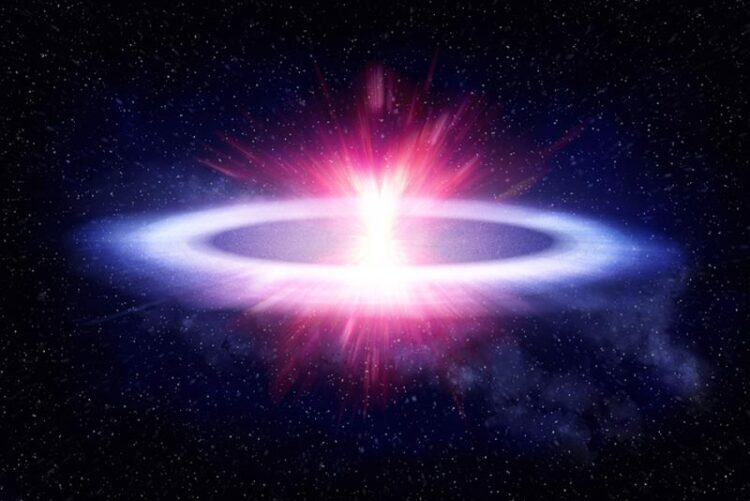Scientists observe flattest explosion ever seen in space

Slim Boom
Credit: Phil Drury, University of Sheffield
Astronomers have observed an explosion 180 million light years away which challenges our current understanding of explosions in space, that appeared much flatter than ever thought possible.
- Astronomers have observed an explosion 180 million light years away which challenges our current understanding of explosions in space, that appeared much flatter than ever thought possible
- Explosions are almost always expected to be spherical, as the stars themselves are spherical, but this one is the flattest ever seen
- The explosion observed was an extremely rare Fast Blue Optical Transient (FBOT) – known colloquially amongst astronomers as “the cow” – only four others have ever been seen, and scientists don’t know how they occur, but this discovery has helped solve part of the puzzle
- A potential explanation for how this explosion occurred is that the star itself may have been surrounding by a dense disk or it may have been a failed supernova
An explosion the size of our solar system has baffled scientists, as part of its shape – similar to that of an extremely flat disc – challenges everything we know about explosions in space.
The explosion observed was a bright Fast Blue Optical Transient (FBOT) – an extremely rare class of explosion which is much less common than other explosions, such as supernovas. The first bright FBOT was discovered in 2018 and given the nickname “the cow”.
Explosions of stars in the universe are almost always spherical in shape, as the stars themselves are spherical. However, this explosion, which occurred 180 million light years away, is the most aspherical ever seen in space, with a shape like a disc emerging a few days after it was discovered. This section of the explosion may have come from material shed by the star just before it exploded.
It’s still unclear how bright FBOT explosions occur, but it’s hoped that this observation, published in Monthly Notices of the Royal Astronomical Society, will bring us closer to understanding them.
Dr Justyn Maund, Lead Author of the study from the University of Sheffield’s Department of Physics and Astronomy, said: “Very little is known about FBOT explosions – they just don’t behave like exploding stars should, they are too bright and they evolve too quickly. Put simply, they are weird, and this new observation makes them even weirder.
“Hopefully this new finding will help us shed a bit more light on them – we never thought that explosions could be this aspherical. There are a few potential explanations for it: the stars involved may have created a disc just before they died or these could be failed supernovas, where the core of the star collapses to a blackhole or neutron star which then eats the rest of the star.
“What we now know for sure is that the levels of asymmetry recorded are a key part of understanding these mysterious explosions, and it challenges our preconceptions of how stars might explode in the Universe.”
Scientists made the discovery after spotting a flash of polarised light completely by chance. They were able to measure the polarisation of the blast – using the astronomical equivalent of polaroid sunglasses – with the Liverpool Telescope (owned by Liverpool John Moores University) located on La Palma.
By measuring the polarisation, it allowed them to measure the shape of the explosion, effectively seeing something the size of our Solar System but in a galaxy 180 million light years away. They were then able to use the data to reconstruct the 3D shape of the explosion, and were able to map the edges of the blast – allowing them to see just how flat it was.
The mirror of the Liverpool Telescope is only 2.0m in diameter, but by studying the polarisation the astronomers were able to reconstruct the shape of the explosion as if the telescope had a diameter of about 750km.
Researchers will now undertake a new survey with the international Vera Rubin Observatory in Chile, which is expected to help discover more FBOTs and further understand them.
For more information contact: Amy Huxtable, Media Relations Officer at the University of Sheffield, a.l.huxtable@sheffield.ac.uk or mediateam@sheffield.ac.uk
Journal: Monthly Notices of the Royal Astronomical Society
DOI: 10.1093/mnras/stad539
Method of Research: Observational study
Subject of Research: Not applicable
Article Title: A flash of polarized optical light points to an aspherical “cow”
Article Publication Date: 31-Mar-2023
Media Contact
Amy Pullan
University of Sheffield
a.l.pullan@sheffield.ac.uk
Office: 01-142-229-859
All latest news from the category: Physics and Astronomy
This area deals with the fundamental laws and building blocks of nature and how they interact, the properties and the behavior of matter, and research into space and time and their structures.
innovations-report provides in-depth reports and articles on subjects such as astrophysics, laser technologies, nuclear, quantum, particle and solid-state physics, nanotechnologies, planetary research and findings (Mars, Venus) and developments related to the Hubble Telescope.
Newest articles

Innovative 3D printed scaffolds offer new hope for bone healing
Researchers at the Institute for Bioengineering of Catalonia have developed novel 3D printed PLA-CaP scaffolds that promote blood vessel formation, ensuring better healing and regeneration of bone tissue. Bone is…

The surprising role of gut infection in Alzheimer’s disease
ASU- and Banner Alzheimer’s Institute-led study implicates link between a common virus and the disease, which travels from the gut to the brain and may be a target for antiviral…

Molecular gardening: New enzymes discovered for protein modification pruning
How deubiquitinases USP53 and USP54 cleave long polyubiquitin chains and how the former is linked to liver disease in children. Deubiquitinases (DUBs) are enzymes used by cells to trim protein…


